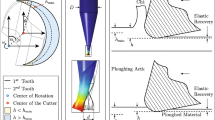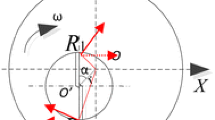Abstract
Micro-milling has shown great potential in producing complex miniaturized components over wide range of materials. It can also fabricate micro-products in small batches efficiently and economically. In spite of these advantages, several challenges hinder its ability to produce components with better dimensional accuracy. Among several factors, tool deflection is one of the major sources of surface error on machined parts and features. Therefore, it is necessary to develop accurate and reliable process models to analyze and improve performance of the process. This study presents a methodology to determine cutting forces and surface error in the presence of tool deflections for micro-milling operation. Tool deflections have considerable influence on instantaneous uncut chip thickness. As tool deflection alters tooth trajectories and instantaneous uncut chip thickness, the rigid cutting force model needs to be modified suitably to consider the effect of deflections. This aspect has been incorporated in the model by modifying tool center location and tooth trajectories iteratively. The convergence of an iterative algorithm determining stable chip thickness is obtained by comparing RMS deviation of average chip thickness between two successive tooth passes. The axial variation of surface error due to tool deflections is estimated using surface generation mechanism. The proposed model is implemented in the form of a computational program to predict cutting force and surface error. The results of computational model are substantiated further by conducting machining experiments. It is shown that the proposed model predicts cutting forces fairly well in the presence of tool deflections. A comparison between predicted variation of surface error and 3D images of machined surface captured using optical microscope showed good qualitative agreement in the error profiles.
Similar content being viewed by others
References
Altinga L, Kimurab F, Hansena HN, Bissacco GB (2003) Micro engineering. CIRP Ann Manuf Technol 52:635–657
Chae J, Park SS, Freiheit T (2006) Investigation of micro-cutting operations. Int J Mach Tools Manuf 46:313–332. https://doi.org/10.1016/j.ijmachtools.2005.05.015
Bao WY, Tansel IN (2000) Modeling micro-end-milling operations. Part I: analytical cutting force model. Int J Mach Tools Manuf 40:2155–2173. https://doi.org/10.1016/S0890-6955(00)00054-7
Cheng KAI, Huo D (2013) Micro-cutting: fundamentals and applications. Wiley, UK
Weule H, Huntrupl V, Tritschlerl H (2001) Micro-cutting of steel to meet new requirements in miniaturization. CIRP Ann Manuf Technol 50:61–64
Kim JD, Kim DS (1995) Theoretical analysis of micro-cutting characteristics in ultra-precision machining. 49:387–398
Vogler MP, Kapoor SG, DeVor RE (2004) On the modeling and analysis of machining performance in micro-endmilling, part II: cutting force prediction. J Manuf Sci Eng 126:695. https://doi.org/10.1115/1.1813471
Park SS, Malekian M (2009) Mechanistic modeling and accurate measurement of micro end milling forces. CIRP Ann Manuf Technol 58:49–52. https://doi.org/10.1016/j.cirp.2009.03.060
Liu X, DeVor RE, Kapoor SG, Ehmann KF (2004) The mechanics of machining at the microscale: assessment of the current state of the science. J Manuf Sci Eng 126:666. https://doi.org/10.1115/1.1813469
Moges TM, Desai KA, Rao PVM (2016) Improved process geometry model with cutter runout and elastic recovery in micro-end milling. Proc of 44th NAMRI/SME 5:478–494. https://doi.org/10.1016/j.promfg.2016.08.040
Bissacco G, Hansen HN, Slunsky J (2008) Modelling the cutting edge radius size effect for force prediction in micro milling. CIRP Ann Manuf Technol 57:113–116. https://doi.org/10.1016/j.cirp.2008.03.085
Moges TM, Desai KA, Rao PVM (2017) On modeling of cutting forces in micro-end milling operation. Mach Sci Technol 344:1–20. https://doi.org/10.1080/10910344.2017.1336179
Vogler MP, DeVor RE, Kapoor SG (2004) On the modeling and analysis of machining performance in micro-endmilling, part I: surface generation. J Manuf Sci Eng 126:685. https://doi.org/10.1115/1.1813470
Kouravand S, Imani BM (2014) Develo** a surface roughness model for end-milling of micro-channel. Mach Sci Technol 18:299–321. https://doi.org/10.1080/10910344.2014.897846
Lee K, Dornfeld D (2005) Micro-burr formation and minimization through process control. Precis Eng 29:246–252. https://doi.org/10.1016/j.precisioneng.2004.09.002
Kiswanto G, Zariatin DL, Ko TJ (2015) The effect of spindle speed, feed-rate and machining time to the surface roughness and burr formation of aluminum alloy 1100 in micro-milling operation. J Manuf Process 16:435–450. https://doi.org/10.1016/j.jmapro.2014.05.003
Wang Z, Kovvuri V, Araujo A et al (2016) Built-up-edge effects on surface deterioration in micromilling processes. J Manuf Process 24:321–327. https://doi.org/10.1016/j.jmapro.2016.03.016
Dow TA, Miller EL, Garrard K (2004) Tool force and deflection compensation for small milling tools. Precis Eng 28:31–45. https://doi.org/10.1016/S0141-6359(03)00072-2
Uriarte L, Herrero A, Zatarain M et al (2007) Error budget and stiffness chain assessment in a micromilling machine equipped with tools less than 0.3mm in diameter. Precis Eng 31:1–12. https://doi.org/10.1016/j.precisioneng.2005.11.010
Biermann D, Kahnis P (2009) Analysis and simulation of size effects in micromilling. Prod Eng 4:25–34. https://doi.org/10.1007/s11740-009-0201-1
Bao WY, Tansel IN (2000) Modeling micro-end-milling operations. Part II: tool run-out. Int J Mach Tools Manuf 40:2175–2192. https://doi.org/10.1016/S0890-6955(00)00055-9
Zaman MT, Kumar AS, Rahman M, Sreeram S (2006) A three-dimensional analytical cutting force model for micro end milling operation. Int J Mach Tools Manuf 46:353–366. https://doi.org/10.1016/j.ijmachtools.2005.05.021
Kang IS, Kim JS, Kim JH et al (2007) A mechanistic model of cutting force in the micro end milling process. J Mater Process Technol 187–188:250–255. https://doi.org/10.1016/j.jmatprotec.2006.11.155
Jun MBG, Liu X, DeVor RE, Kapoor SG (2006) Investigation of the dynamics of microend milling—part I: model development. J Manuf Sci Eng 128:893. https://doi.org/10.1115/1.2193546
Altintas Y, ** X (2011) Mechanics of micro-milling with round edge tools. CIRP Ann Manuf Technol 60:77–80. https://doi.org/10.1016/j.cirp.2011.03.084
Rao S, Shunmugam MS (2012) Analytical modeling of micro end-milling forces with edge radius and material strengthening effects. Mach Sci Technol 16:205–227. https://doi.org/10.1080/10910344.2012.673966
Lai X, Li H, Li C, et al (2008) Modelling and analysis of micro scale milling considering size effect, micro cutter edge radius and minimum chip thickness. Int J Mach Tools Manuf 48:1–14. doi: https://doi.org/10.1016/j.ijmachtools.2007.08.011
Afazov SM, Ratchev SM, Segal J (2010) Modelling and simulation of micro-milling cutting forces. J Mater Process Technol 210:2154–2162. https://doi.org/10.1016/j.jmatprotec.2010.07.033
** X, Altintas Y (2012) Prediction of micro-milling forces with finite element method. J Mater Process Technol 212:542–552. https://doi.org/10.1016/j.jmatprotec.2011.05.020
Li C, Lai X, Li H, Ni J (2007) Modeling of three-dimensional cutting forces in micro-end-milling. J Micromech Microeng 17:671–678. https://doi.org/10.1088/0960-1317/17/4/001
Pérez H, Vizán A, Hernandez JC, Guzmán M (2007) Estimation of cutting forces in micromilling through the determination of specific cutting pressures. J Mater Process Technol 190:18–22. https://doi.org/10.1016/j.jmatprotec.2007.03.118
Malekian M, Park SS, Jun MBG (2009) Modeling of dynamic micro-milling cutting forces. Int J Mach Tools Manuf 49:586–598. https://doi.org/10.1016/j.ijmachtools.2009.02.006
Jun MBG, Goo C, Malekian M, Park S (2012) A new mechanistic approach for micro end milling force modeling. J Manuf Sci Eng 134:11006. https://doi.org/10.1115/1.4005429
Kline WA, DeVor RE, Lindberg JR (1982) The prediction of cutting forces in end milling with application to cornering cut. Int J Mach Tool Des Res 22:7–22
Ryu SH, Lee HS, Chu CN (2003) The form error prediction in side wall machining considering tool deflection. Int J Mach Tools Manuf 43:1405–1411. https://doi.org/10.1016/S0890-6955(03)00183-4
Mijušković G, Krajnik P, Kopač J (2013) Analysis of tool deflection in micro milling of graphite electrodes. Int J Adv Manuf Technol 76:209–217. https://doi.org/10.1007/s00170-013-5536-2
Budak E, Altintas Y (1995) Modeling and avoidance of static form errors in peripheral milling of plates. Int J Mach Tools Manuf 35:459–476
Mamedov A, Layegh KSE, Lazoglu I (2015) Instantaneous tool deflection model for micro milling. Int J Adv Manuf Technol 79:769–777. https://doi.org/10.1007/s00170-015-6877-9
Tsai J, Liao C (1999) Finite-element modeling of static surface errors in the peripheral milling of thin-walled workpieces. 94:235–246
Gye H-R, Song B-U, Lim Y-S, et al (2013) Prediction of cutting force and tool deflection in micro flat end milling. Int J Mater Mech Manuf 1:13–16. doi: https://doi.org/10.7763/IJMMM.2013.V1.3
Uriarte L, Azcárate S, Herrero A, et al (2008) Mechanistic modelling of the micro end milling operation. Proc Inst Mech Eng Part B J Eng Manuf 222:23–33. doi: https://doi.org/10.1243/09544054JEM837
Rodríguez P, Labarga JE (2013) A new model for the prediction of cutting forces in micro-end-milling operations. J Mater Process Technol 213:261–268
Zhang X, Ehmann KF, Yu T, Wang W (2016) Cutting forces in micro-end-milling processes. Int J Mach Tools Manuf 107:21–40. https://doi.org/10.1016/j.ijmachtools.2016.04.012
Mamedov A, Layegh KSE, Lazoglu I (2013) Machining forces and tool deflections in micro milling. Procedia CIRP 8:147–151. https://doi.org/10.1016/j.procir.2013.06.080
Wang S, Chen D, Jang M, Tsooj S (2012) Development of micro milling force model and cutting parameter optimization. Trans Nonferrous Met Soc China 22:s851–s858. https://doi.org/10.1016/S1003-6326(12)61815-9
Kops L, Vo DT (1990) Determination of the equivalent diameter of an end mill based on its compliance. 3:93–96
Hibbeler RC (2014) Mechanics of materials. In: Deflection of beams and shafts, 9th edn. Prentice Hall, USA, pp 573–659
Sutherland JW, Devor RE (2016) An improved method for cutting force and surface error prediction in flexible end milling systems. J Manuf Sci Eng 1986;108:269–279
Wan M, Zhang WH (2005) Calculations of chip thickness and cutting forces in flexible end milling. Int J Adv Manuf Technol 29:637–647. https://doi.org/10.1007/s00170-005-2572-6
Desai KA, Rao PVM (2012) On cutter deflection surface errors in peripheral milling. J Mater Process Technol 212:2443–2454. https://doi.org/10.1016/j.jmatprotec.2012.07.003
Acknowledgements
The authors thank Dr. J RamKumar, Mechanical Engineering Department at the IIT Kanpur for his permission to use the laboratory facilities to conduct micro-milling experiments and staff of the Nanoscale Research Facility (NRF) at the IIT Delhi for useful support during measurement of surface error variation.
Author information
Authors and Affiliations
Corresponding author
Rights and permissions
About this article
Cite this article
Moges, T.M., Desai, K.A. & Rao, P.V.M. Modeling of cutting force, tool deflection, and surface error in micro-milling operation. Int J Adv Manuf Technol 98, 2865–2881 (2018). https://doi.org/10.1007/s00170-018-2415-x
Received:
Accepted:
Published:
Issue Date:
DOI: https://doi.org/10.1007/s00170-018-2415-x




